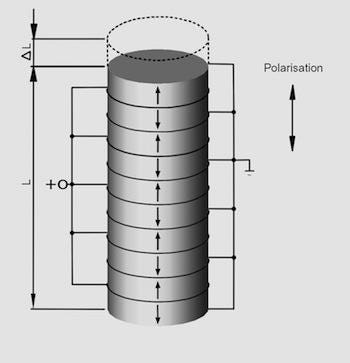August 16, 2013

At the heart of piezoelectric flexure actuators is an exquisite stack of layers of specialized ceramic. These layers, only a few dozen microns thick, are interleaved with electrodes and sintered into a solid structure. The most common piezo ceramic for high-performance positioning applications is lead-zirconate-titanate (PZT), a ferroelectric ceramic. This material is useful for positioning because it exhibits a small but almost linear dimensional change as voltage is applied across the electrodes. This provides a precise, controllable motion input to the engineer's mechanism. Position changes on the order of nanometers can be achieved without difficulty.
The operation of the ceramic element is characterized by four factors: precision, speed, short travel, and high force.
The stack's positioning precision comes from its almost linear dimensional change, which is free of stiction effects and can allow controllability down into the subnanometer range. This is why piezoelectric mechanisms are at the heart of today's semiconductor lithography tools, atomic-force microscopes, and the other nanoscale-precision systems.

Its speed comes from the solid-state actuation of the stack, which propagates at the speed of sound through the material, yielding responsiveness into the kHz region, with correspondingly impressive force capability. The speed-of-sound actuation also means that piezo actuators can respond to an input in microseconds. This makes them suitable to applications such as valve control and nano-dosing, where nanometer precision is infrequently of secondary importance.
Its travel limitation comes from the maximum strain the actuators can achieve -- typically about 1 percent of their length. Consequently, piezoelectric flexure actuators utilize frictionless lever amplifiers that magnify the actuator motion. Clever design means motion ranges of up to 2mm can be achieved in compact packages.
Until recently, piezoelectric flexure actuators have been employed mostly inside specialized piezoelectric stages for ultra-precision positioning applications and were not easily available to the OEM mechanical engineer. That has changed, and flexure actuators with long travels are now available as off-the-shelf items for ready integration into custom mechanisms. This new accessibility has opened the door for a wide variety of specialized mechanisms across a broad spectrum of industries.
Broad choices, new options
The new piezoelectric flexure actuators complement and extend the portfolio of form factors and packaging styles for piezoelectric actuators.
Ceramic stacks, with or without integrated position sensors, have traditionally been available to engineers wishing to perform all integration. Packaged actuators have commonly been used for applications needing easy mounting and integral low-stiction preloads for dynamic actuation.
The new breed of fully integrated flexure actuators now offer preconfigured subassemblies that integrate stictionless lever amplification, as well as preload elements and optional position feedback. Thus, piezoelectric flexure actuators offer especially easy mounting for the greatest convenience and performance for research and OEM applications, and they require the least specialized engineering to design in and implement.
All these choices share the common benefits of piezoelectric actuators, such as nanoscale precision, high speed and force, solid-state and lubricant-free actuation, nonmagnetic and field-free operation, and vacuum compatibility.
About the Author(s)
You May Also Like





